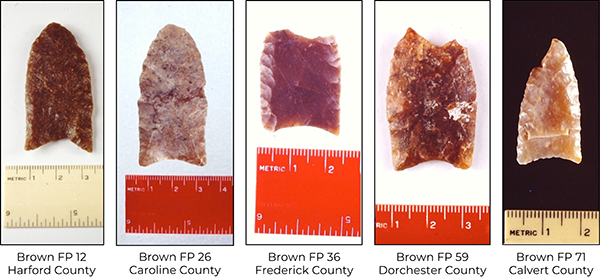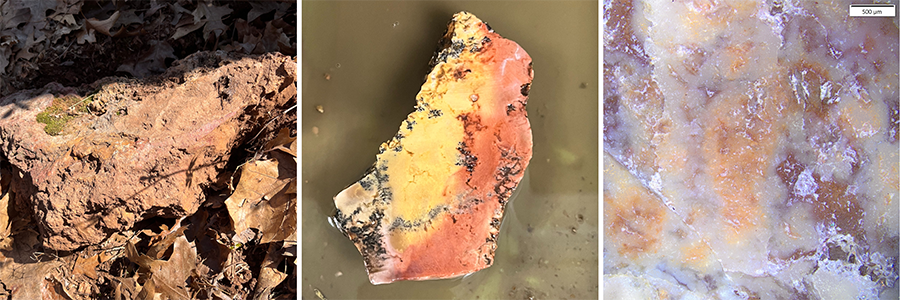 Click image to enlarge.
Click image to enlarge.
The Maryland
Fluted Point Survey documents stone projectile points made by the
Paleoindians who lived in
Maryland between 13,000 and 10,000 years ago. A fluted point has distinctive channels, or "flutes," struck
from the base to help secure the stone tool onto a shaft. The survey systematically records information
about these points, recovered during excavations or identified in collections, including their history of
discovery and contemporary ownership, locational information, fluted point type, and stone raw material.
By collecting data in a statewide survey, researchers can begin to identify patterns that might shed
new light on the lives of Paleoindians.
Through the survey, researchers became interested in a distinctive stone called “weathering amber
chalcedony,” which fluted point makers used in Maryland and the surrounding Mid-Atlantic region. The
stone – an amber-colored chalcedony that occasionally develops a white patina – was primarily used to make
stone tools toward the end of the Pleistocene (or “Ice Age”). Later people did not regularly use this
stone, perhaps because the limited supply was mostly used up, or because later people had different
strategies for procuring stone.
Piney Grove Site
Located in Reisterstown, the Piney Grove site (18BA483) was discovered in 2001, when archaeologists from
the Maryland State Highways Administrations and Goodwin and Associates conducted archaeological
investigations in advance of a proposed intersection improvement project.
Piney
Grove yielded chipping debris of weathering amber chalcedony, suggesting a quarry-related workshop
where Paleoindians found large chalcedony cobbles and then knapped them into stone tools. The chipping
debris including overshot flakes, end thinning flakes, and channel flakes suggests 13,000-year-old Clovis
fluted point production — or in other words, stone tools made by one of the earliest widespread cultures
in North America.
Because this chalcedony is so clearly associated with Ice Age inhabitants in the region, finding a
source area of the stone can help answer important research questions. Archaeologists can study the
production process for shaping cobbles into stone tools, for example, or the location of the stone
and potential factors that influenced the procurement of this stone, like its visibility, ease of
collection, and associated with preferred landscapes and habitats.
MHT archaeologists returned
to Piney Grove in October 2024 to attempt to locate additional intact archaeological deposits. Over
the five-day project, volunteer archaeologists excavated 56 shovel test pits in a four-meter grid in
an effort to locate stone tools and chipping debris associated with the chalcedony.
While the vast majority of the test pits did not yield artifacts, five did recover weathering amber
chalcedony, including seven pieces of chipping debris and
one
fragment of a scraping tool called
a sidescraper. The scraping
tool fragment is the first formal tool made of the stone to be found at the Piney Grove site, since
the 2001 excavations primarily documented stone tool production areas, where tools were made and
carried away to be used elsewhere.
Three shovel test pits that produced chalcedony artifacts are located nearby each other, which
indicate that the 2024 investigation identified an intact activity area where people made and
used tools in the past.
Chalcedony Geological Study
MHT is collaborating
with the Maryland Geological Survey to study the formation and geological distribution of
the weathering amber chalcedony to better understand how past people may have found and collected
the stone to make tools. So far, research has focused on chalcedony float (or cobbles) found in
association with serpentinite rocks in Baltimore County. The chalcedony is being examined
macroscopically, microscopically, and geochemically to identify the composition of the stone and
where the stone originally formed. This information, in turn, will help reveal potential sources
of chalcedony and additional insights into ancient toolstone procurement techniques and the
movements of early peoples in Baltimore County.
 Left to right: chalcedony float found in Baltimore County;
chalcedony thick section slice; microscopy photograph of chalcedony patina. Click
image to enlarge.
Left to right: chalcedony float found in Baltimore County;
chalcedony thick section slice; microscopy photograph of chalcedony patina. Click
image to enlarge.